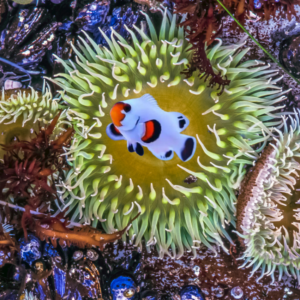Types of Clownfish
1. Introduction: Types of Clownfish
Ever since “Finding Nemo” swam into our hearts, the interest in keeping clownfish has skyrocketed. As an enthusiast and advisor, I’ve come to appreciate the diverse world of these colorful marine creatures. In this guide, I’ll share insights into the different types of clownfish, their care, feeding habits, and more. Dive in with me to explore the vibrant life of clownfish.
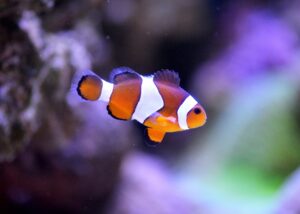
10 Mind-blowing Facts About Clownfish
A Brief Overview of Clownfish
Clownfish, or anemonefish as they’re scientifically known, are the jewels of the ocean. Dwelling in the warm waters of the Pacific and Indian Oceans, these fish form a unique symbiotic relationship with sea anemones. The anemones provide clownfish with protection from predators, thanks to their venomous tentacles, to which clownfish are immune due to a special mucous coating. In return, clownfish help lure food towards the anemone and clean up its leftovers, showcasing a perfect example of nature’s balance.
Their diet is as colorful as their appearance, consisting of algae, zooplankton, and the occasional small crustacean. What truly sets clownfish apart is their vibrant palette, ranging from the softest yellows to the deepest maroons, each species marked by distinctive bands or patterns that make them a favorite among aquarium enthusiasts worldwide.
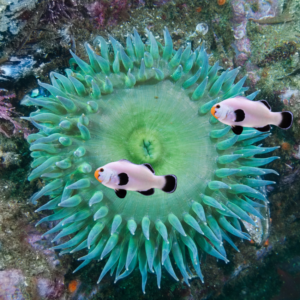
The Importance of Understanding Different Types of Clownfish
Diving into the world of clownfish is like uncovering a treasure trove of biodiversity. There are over a hundred different type of clownfish. Each type of clownfish boasts unique characteristics that influence not only their care requirements but also their role within the marine ecosystem. For example, the peaceful and relatively small Ocellaris clownfish contrasts sharply with the larger and more territorial Maroon clownfish.
For those of us who keep these creatures in our homes, understanding these differences is crucial. It influences everything from tank size and companions to diet and habitat setup, ensuring our aquatic friends thrive. Furthermore, this knowledge underscores the importance of conservation, highlighting how each species plays a role in the delicate balance of marine ecosystems.
The Amphiprion Ocellaris Clownfish
The ocellaris clownfish is characterized by its vibrant orange color, three white bands with fine black edging, a small size of about 3 to 4 inches, and a peaceful temperament. It is also known for its symbiotic relationship with sea anemones.
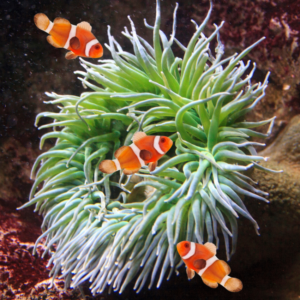
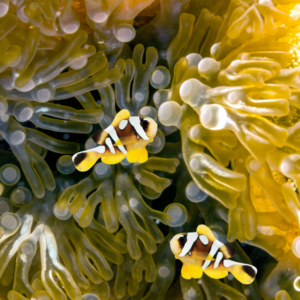
The Wysiwyg ClownFish
The wysiwyg clownfish is recognized for its unique and striking spotted pattern against a white background, accented by vibrant orange on the fins and face. These clownfish are often captive-bred with a focus on unique color morphs, showcasing the diversity within the species. They maintain the typical symbiotic relationships with anemones, similar to naturally occurring clownfish.
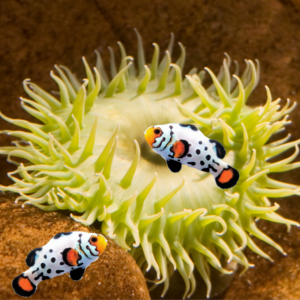
Bullethole or Bumblebee Clownfish
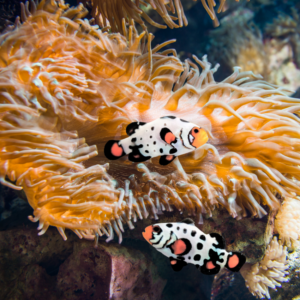
As we delve deeper into the world of clownfish, let’s celebrate the diversity and complexity of these marine wonders. By understanding and respecting their unique needs and behaviors, we can create harmonious underwater worlds that echo the beauty and intricacy of their natural habitats.
This introduction and overview set the stage for a deeper exploration into the types, care, and compatibility of clownfish, tailored to engage and inform both seasoned aquarists and curious newcomers. The full article would continue to unpack each section with detailed care guides, compatibility advice, and feeding tips, culminating in a comprehensive resource for anyone passionate about these marine treasures.
2. Understanding Clownfish
Clownfish, or anemonefish, are famed for their symbiotic relationship with sea anemones. This partnership allows them to thrive in the wild, offering protection and food. Primarily found in the warm waters of the Pacific and Indian Oceans, clownfish have adapted to a range of marine environments.
a. Symbiotic Relationship with Anemones
The symbiotic relationship between clownfish and sea anemones is a fascinating dance of nature’s intricacies. Clownfish live among the venomous tentacles of anemones, protected from predators by a unique immunity to the anemone’s sting. In exchange, clownfish offer their hosts benefits like improved water circulation and nutrient supply from their waste. This mutualistic relationship allows both species to thrive; clownfish gain a safe haven and nesting ground, while anemones receive cleaning services and better chances at capturing prey. Understanding this partnership is key to replicating a natural and healthy environment for clownfish in aquariums.
Black Saddleback Clownfish
Two Saddleback Clownfish swimming near a vibrant blue and yellow anemone. The fish have a distinctive white stripe running down their backs (saddle), along with black and white stripes across their bodies. The anemone has long, thin tentacles that create a beautiful contrast against the dark background.
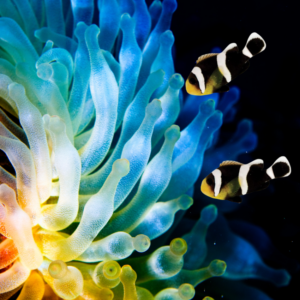
b. Habitat and Distribution
Clownfish are predominantly found in the shallow reefs of the Pacific and Indian Oceans, stretching from the coast of Southeast Asia to Japan and Australia. These warm waters provide the ideal conditions for both clownfish and their anemone partners. Clownfish are territorial animals, often residing in a single anemone throughout their lives. Their distribution across various reefs is heavily influenced by the presence of suitable sea anemones, which varies significantly across different water bodies. This habitat preference underscores the importance of preserving coral reefs to ensure the survival of clownfish populations in the wild.
3.The Different Types of Clownfish
The Different Types of Clownfish
The Different Types Diving into the vibrant world of clownfish reveals a spectrum of colors and personalities. Each species has adapted to its niche in the ocean, showcasing unique characteristics that make them fascinating subjects for marine enthusiasts and aquarium keepers alike. Let’s explore some of the most popular types of clownfish that captivate our hearts and tanks.
a. Common Clownfish (Amphiprion ocellaris)
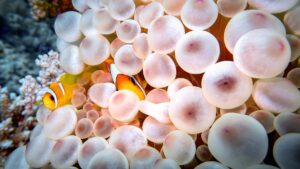
The Common Clownfish, or “Nemo” as it’s affectionately known, is arguably the most recognized species, thanks to its starring role in popular culture. Sporting a bright orange body with three distinctive white bands wrapped around its width, the Amphiprion ocellaris thrives in a variety of sea anemone species. This species boasts hardiness and adaptability, rendering it an ideal choice for both novice and experienced aquarists. You can find Common Clownfish in the warm waters of the Western Pacific, ranging from the coasts of Japan and the South China Sea down to Australia.
b. Tomato Clownfish (Amphiprion frenatus)
The Tomato Clownfish is noted for its striking, deep red-orange hue and a single white band behind the eyes. Larger and slightly more aggressive than the Common Clownfish, Amphiprion frenatus prefers the company of larger sea anemone species. They are robust and can adapt to a variety of tank conditions, making them popular among hobbyists. Their natural habitat stretches across the Western Pacific, from Japan to Indonesia and the Philippines, where they navigate the reef territories with confidence.
c. Clownfish (Premnas biaculeatus)
Distinguished by its vibrant maroon color and thicker, more pronounced white bands, the Maroon Clownfish is the largest and most territorial of the clownfish species. Unique to this species is the gold-striped variant, which develops its striking gold bands as it matures. The Maroon Clownfish requires a larger tank to accommodate its aggressive temperament, especially during breeding. Native to the Indo-Pacific region, these fish are often found in lagoons and outer reefs where they form a strong pair bond with their chosen anemone.
d. Clownfish (Genus Amphiprion)
Skunk Clownfish are characterized by their distinctive white dorsal stripe that runs from the nose to the base of the tail, against a backdrop ranging from pale yellow to dark black. This genus includes several species, such as the Orange Skunk Clownfish (Amphiprion sandaracinos) and the Pink Skunk Clownfish (Amphiprion perideraion), each preferring different anemone hosts. Known for their peaceful nature, Skunk Clownfish make excellent community tank members. They are widespread across the Indo-Pacific, preferring shallow lagoons and reef fronts where sunlight dances through the water.
4.Care and Maintenance
Proper care and maintenance are pivotal for the health and happiness of clownfish in captivity. By mimicking their natural habitat as closely as possible, you provide these colorful marine creatures with a safe and comfortable environment. Here’s a breakdown of the essential care aspects, focusing on tank requirements and water conditions.
a. Tank Requirements
The size and setup of the aquarium play a crucial role in the well-being of clownfish. A minimum tank size of 20 gallons is recommended for a pair of small clownfish, but if you plan to house larger species or multiple pairs, you’ll need a larger tank to prevent territorial disputes and stress. The aquarium should include plenty of hiding spots and live rock for them to explore and claim as territory. Simulating their natural environment, consider incorporating a host anemone or similar structures to provide a sense of security and normalcy, although it’s not strictly necessary for their survival in captivity. Adequate filtration and a stable tank cycle are essential to keep the water clean and free from harmful toxins.
b. Water Conditions
Maintaining optimal water conditions is critical for the health of clownfish. The temperature should be kept between 75-82°F (24-28°C) to replicate their tropical habitat. The pH level should be stable, ranging from 8.0 to 8.4, with salinity levels of 1.020 to 1.026 specific gravity to mimic ocean water. Regular water changes, ideally 10-15% bi-weekly, are necessary to keep the nitrate levels low and remove any pollutants. It’s also important to monitor ammonia and nitrite levels closely, ensuring they remain at zero to prevent stress and disease. Proper lighting, while more crucial for the health of live plants and anemones, should also be considered to maintain a natural day-night cycle for the clownfish.
By paying close attention to these care and maintenance guidelines, enthusiasts can create a thriving aquarium where clownfish can exhibit their natural behaviors and live a healthy, stress-free life. Whether you’re a beginner or an experienced aquarist, understanding the needs of your clownfish is the first step towards fostering a vibrant and harmonious underwater community.
5.Different Types of Clownfish

Feeding clownfish appropriately is vital for their health, coloration, and overall well-being. Each type of clownfish may have its unique preferences, but fortunately, they share similar dietary needs. Understanding these preferences and employing the right feeding strategies can ensure your aquatic friends thrive in their home aquarium.
a. Diet Preferences
Clownfish are omnivores, requiring a mix of meaty foods and algae-based foods to meet their nutritional needs. In the wild, their diet includes small zooplankton, algae, and crustaceans. In captivity, a varied diet of high-quality, commercially available marine flakes, pellets designed for clownfish, frozen foods such as brine shrimp, mysis shrimp, and chopped krill, along with algae sheets or pellets, can provide them with the necessary nutrients. Some types of clownfish may show a preference for certain foods over others, but offering a variety ensures they receive a balanced diet. For example, the Tomato Clownfish might be more aggressive in feeding and can benefit from slightly larger, meatier foods, whereas the Common Clownfish might readily accept a wider variety of offerings.
b. Feeding Tips
- Consistency is Key: Feed your clownfish 2-3 times a day in small amounts that they can consume within a few minutes to avoid overfeeding and polluting the tank.
- Variety: Rotate their diet between different types of food to ensure they receive a range of nutrients. This not only keeps your clownfish healthy but also stimulates their appetite and reduces boredom.
- Observe: Pay close attention to your clownfish during feeding times. This observation allows you to adjust their diet based on their preferences and ensures all fish are getting their share, especially in a community tank.
- Soak Dry Foods: Soaking dry pellets or flakes in aquarium water or a vitamin supplement before feeding can enhance the food’s nutritional value and make it easier for the clownfish to eat.
- Consider the Anemone: If you have an anemone in your tank, occasionally feeding it directly can benefit both the anemone and clownfish, as clownfish often feed on the leftovers from the anemone’s meals.
By following these dietary preferences and feeding tips, you’ll provide a nurturing environment that supports the health and happiness of your clownfish. Remember, the goal is to replicate their natural diet as closely as possible, which is key to maintaining vibrant, active, and healthy clownfish in your aquarium.
6.Clownfish and Tank Mates
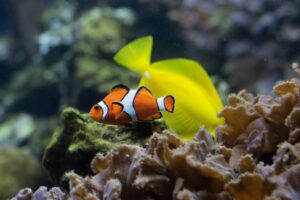
a. Suitable Tank Mates
When selecting tank mates for clownfish, opt for peaceful, non-predatory fish to ensure harmony within the aquarium. Ideal tank mates are peaceful species like gobies, dartfish, and blennies. They don’t fight with clownfish for space or food. Also, peaceful large invertebrates and corals match well with clownfish. They enhance the tank’s diversity and look without causing stress. Avoid aggressive species that may bully or harm clownfish, ensuring a serene and safe environment for all inhabitants.
b. Clownfish Interactions
In their natural habitat and aquariums, clownfish exhibit interesting social behaviors, often establishing a clear hierarchy when in groups. Typically, one female becomes dominant, with a male partner and possibly several non-breeding individuals. Clownfish can become territorial, especially around their anemone homes, but this aggression is usually mild and can be managed with proper tank size and environment. Providing adequate space and hiding spots helps mitigate potential conflicts, allowing for peaceful coexistence and fascinating observation of their social dynamics.
7.Can You Keep Different Types of Clownfish Together?
Keeping different types of clownfish together in the same aquarium is possible, but it requires careful consideration of their specific behaviors and territorial nature. Clownfish are known for establishing a strict hierarchy, especially in confined spaces, which can lead to aggression if not managed properly.
When mixing different species, it’s essential to have a sufficiently large tank to provide ample space for each clownfish to establish its territory, ideally with separate anemones or anemone-like structures for each pair. This reduces competition and stress among the fish. It’s also advisable to introduce different species of clownfish to the aquarium at the same time to prevent established territories and reduce aggression.
However, not all species cohabit peacefully. For example, the larger, more aggressive species like the Maroon Clownfish (Premnas biaculeatus) may bully smaller, more docile species like the Common Clownfish (Amphiprion ocellaris). Therefore, understanding the temperament and size of each species is crucial when considering mixing them in the same tank.
In summary, while you can keep different types of clownfish together, doing so successfully requires a spacious tank, strategic planning regarding species selection, and careful observation to ensure all individuals can coexist without undue stress or aggression.
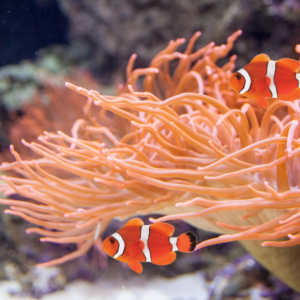
8. Breeding Clownfish
a. Breeding Conditions for Types of Clownfish
Breeding clownfish in captivity requires replicating their natural environment as closely as possible to trigger their breeding instincts. A stable, well-maintained aquarium with ample space is essential, as clownfish need a peaceful environment to form pairs and spawn. The tank should include an anemone or a suitable substitute, like a spawning site, to encourage natural breeding behaviors. Water quality is critical, with optimal parameters being a temperature of 78-80°F (25.5-26.5°C), a pH level of 8.1-8.4, and salinity around 1.020-1.025. Regular light cycles mimic natural day and night periods, further promoting breeding conditions. Feeding a varied, high-quality diet enhances the health and fertility of the clownfish, preparing them for successful spawning.
b. Rearing the Fry
Rearing clownfish fry is a delicate process that requires attention to detail to ensure high survival rates. After hatching, the fry should be moved to a separate, specialized rearing tank to protect them from being eaten or outcompeted for food. This tank must have pristine water conditions, with stable temperature and pH levels, and be equipped with gentle filtration to avoid sucking in the tiny fry. Initially, clownfish fry are fed rotifers, followed by baby brine shrimp as they grow, providing the necessary nutrition for their rapid development. Frequent, small feedings are crucial. Additionally, maintaining a clean environment through regular water changes and careful monitoring of water parameters supports healthy growth during these critical early stages.
9.Common Health Issues and Prevention
Clownfish, with their vibrant colors and engaging personalities, are among the most cherished inhabitants of marine aquariums. However, their resilience does not make them immune to health challenges. Understanding and addressing these common health issues are vital components of responsible clownfish care.
a. Marine Ich
(White Spot Disease) is perhaps the most notorious ailment affecting clownfish. Caused by the parasite Cryptocaryon irritans, it manifests as tiny white cysts on the fish’s skin, fins, and gills, often leading to increased irritation and stress. Affected clownfish might rub against tank decorations or substrate in an attempt to dislodge the parasites. To prevent Ich, maintaining optimal water quality is crucial, alongside the use of UV sterilizers to manage parasite levels in the water. Quarantine procedures for new fish or plants can also help prevent the introduction of Ich into the tank.
b. Brooklynella Hostilis
– also known as “Brook,” specifically targets clownfish and is characterized by a heavy, slime-like mucus coating on the fish, breathing difficulties, lethargy, and eventual loss of appetite. This ailment is aggressive and can rapidly lead to mortality if not addressed promptly. The best prevention strategy includes strict quarantine protocols for new additions to the aquarium and maintaining a stress-free environment for your clownfish through proper feeding, tank management, and avoiding overcrowded conditions.
c. Bacterial Infections
in clownfish often present as sores, ulcers, or unusual redness on the body and fins. Poor water quality and stress are significant contributors to bacterial outbreaks. Regular tank maintenance, including frequent water changes and monitoring of water parameters, is vital for prevention. Additionally, ensuring your clownfish are not subjected to aggressive tank mates and have plenty of space can help reduce stress and vulnerability to bacterial infections
d. Ammonia Poisoning
– is a critical concern, especially in newly set up tanks where the nitrogen cycle has not been fully established. Symptoms include gasping at the surface, lethargy, and inflamed gills. Preventing ammonia poisoning involves cycling the tank properly before introducing clownfish, regular testing of water parameters, and avoiding overfeeding, which can lead to excess waste.
To safeguard the health of clownfish, aquarists should adopt a holistic approach focusing on prevention. This includes:
- Regular Water Testing and Maintenance: Keeping the tank clean and the water parameters within ideal ranges is non-negotiable. Regular testing for ammonia, nitrites, nitrates, pH, and salinity helps identify potential problems before they become serious.
- Quarantine Practices: New fish, coral, or live rock should be quarantined before introduction to the main tank to prevent the spread of diseases.
- Nutritional Diet: Feeding a varied diet rich in vitamins and nutrients supports the immune system of clownfish, making them less susceptible to diseases.
- Stress Reduction: Providing a tank environment that mimics their natural habitat, with plenty of hiding spots and an appropriate social structure, can significantly reduce stress in clownfish.
In conclusion, while clownfish are relatively hardy, they are not impervious to health issues. Emphasize prevention, monitor regularly, and act swiftly when detecting problems to ensure that your beloved marine creatures lead long, healthy lives in your aquarium.
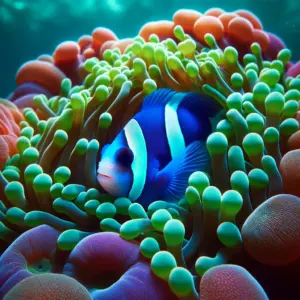
10.Conclusion
In conclusion, the journey of keeping clownfish, those vibrant jewels of the marine aquarium world, is both rewarding and demanding. We covered health issues in clownfish: Marine Ich, Brooklynella, bacterial infections, and ammonia poisoning. Knowing and preventing these can help you manage or avoid them.
FAQs for Types of Clownfish
1. How many different types of clownfish are there?
There are about 30 recognized species of clownfish. Each species varies in size, color, and pattern, inhabiting different areas of the Pacific and Indian Oceans. These species are adapted to live in symbiosis with various sea anemones, showcasing the biodiversity of marine life.
2.What do different types of clownfish eat?
Clownfish are omnivores, meaning they eat both meat and plants. In the wild, their diet primarily consists of algae, zooplankton, worms, and small crustaceans. In aquariums, they thrive on a diet of high-quality marine flake food, pellets, and frozen foods such as brine shrimp and mysis shrimp, supplemented with algae or vegetable matter to mimic their natural diet.
3.Can different types of clownfish be kept together?
Yes, different types of clownfish can be kept together, but it requires careful planning. Ensure the aquarium is spacious enough to prevent territorial disputes and provide plenty of hiding spots. It’s also important to consider the specific temperament and size of each species to minimize aggression and stress.
4.How do you choose tank mates for clownfish?
Choose peaceful, non-predatory fish as tank mates for clownfish to maintain harmony within the tank. Suitable companions include small gobies, dartfish, and blennies. Avoid large or aggressive species that may bully or eat clownfish. Also, consider the environmental needs of potential tank mates to ensure compatibility.
5.Tips for breeding clownfish in home aquariums.
Breeding clownfish at home can be a rewarding experience. Start with a stable, mature aquarium and provide a pair of clownfish with a comfortable environment, including a suitable spawning site like a flat surface or a crevice. Maintain high water quality and feed a varied, nutritious diet to encourage spawning. Watch for mating behavior in the pair and prepare to rear the fry with suitable food and a separate tank for successful breeding.
A Blizzard Clownfish
A Blizzard Clownfish nestled in a green and white anemone. The fish’s white body is covered in black polka dots, creating a stunning contrast against the anemone’s colors. The anemone has long tentacles that curl around the fish, providing protection and shelter. The background is a colorful mix of blues, browns, and reds, suggesting a vibrant coral reef environment.
